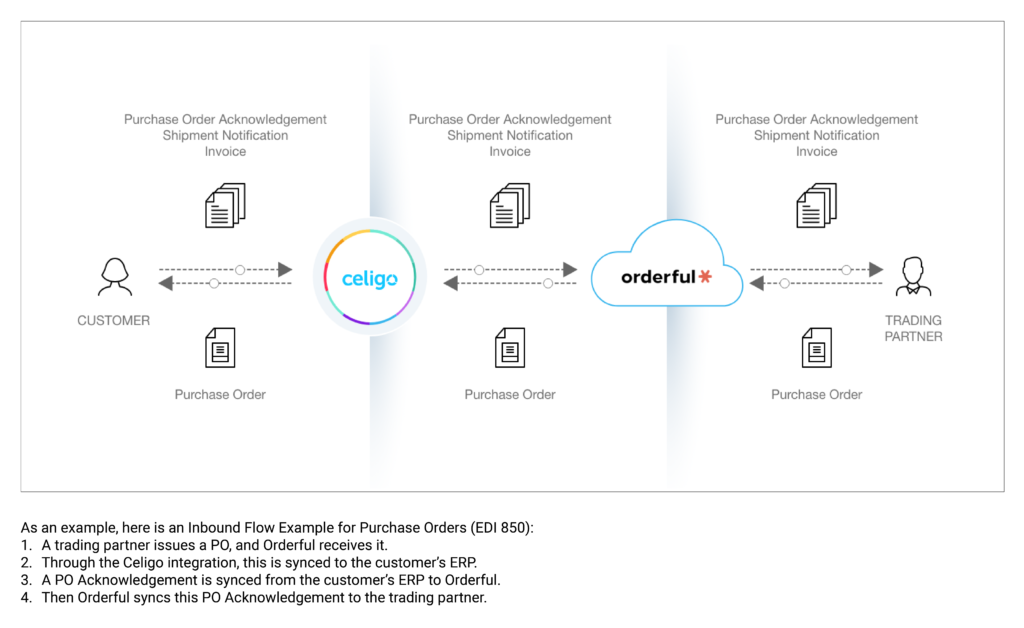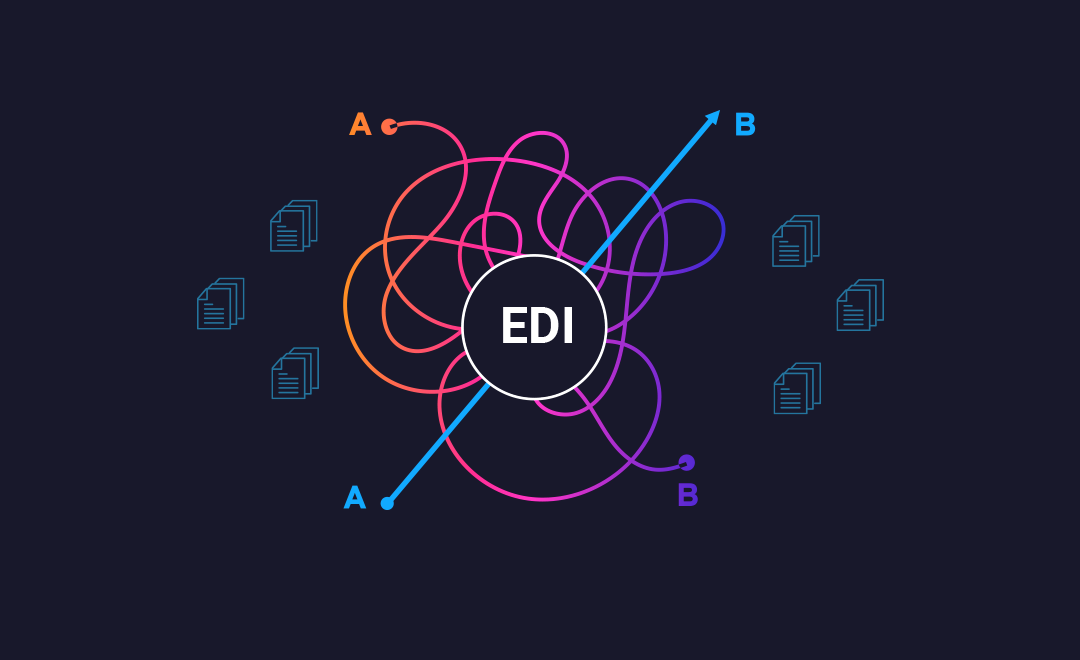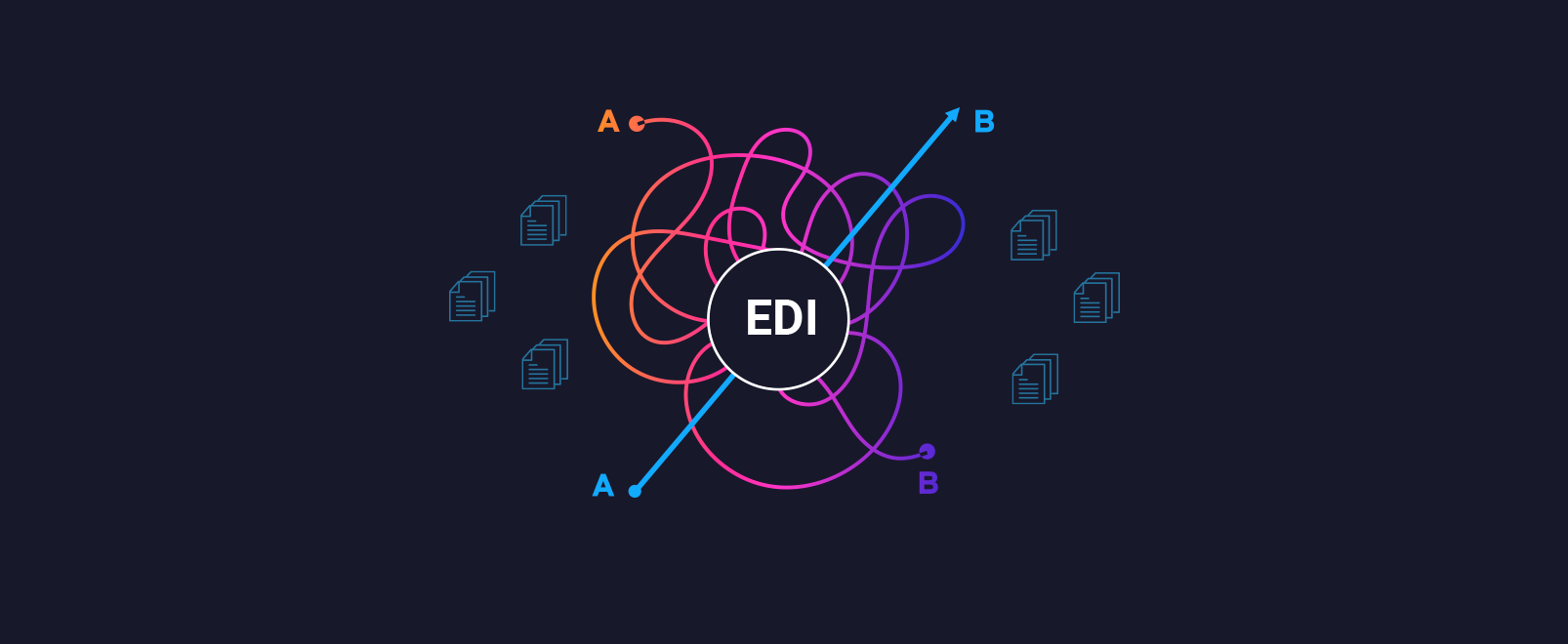EDI Challenges: How Celigo’s Modern, API-Based EDI Integration Solves Them
Today, when most legacy technologies are either obsolete or have been replaced, Electronic Data Interchange, or EDI, continues to be deeply ingrained in the global supply chain market. As the supply chain continues adjusting to modern requirements in omnichannel ecommerce, real-time inventory management, order fulfillment, on-time delivery, and other areas, complex EDI workflows need to evolve, too. In this article, we’ll talk about EDI challenges with legacy solutions and how Celigo’s API-based integration is resolving them.
What is EDI?
First, EDI is the exchange of documents, such as invoices and purchase orders, between business partners electronically. Developed during the pre-internet era, EDI largely replaced the slow, error-prone, paper-based method of exchanging documents via fax, mail, or email.
In addition to the supply chain, some of the other industries that rely on EDI are healthcare, finance, and automotive.
According to a report, the global EDI software market size was $1,547.2 million in 2019. It’s projected to reach $3,451.3 million by 2027, at a compound annual growth rate of 10.7% during the forecast period. One of the reasons why EDI is still so popular is the defined set of standards (ANSI, EDIFACT, X12) and communication protocols (AS2, FTP), which streamlines the whole process of mapping, translating, and exchanging documents.
Let’s understand how EDI works with an example. If a retailer needs to place an order with their supplier using EDI, this is what the process will typically look like:
- Document Preparation: First, a retailer generates a purchase order (PO) using its internal system like an ERP.
- Translation: Next, the PO is converted into an EDI document, in this case EDI 850 (see all document types here).
- Transmission: Using an established secure communication between both partners, EDI 850 is transmitted to the supplier.
3 Common EDI Challenges
Businesses tend to take these two popular approaches for enabling EDI:
- Direct, or Point-to-Point, EDI: Integrate with every trading partner directly, managing all the integrations, mapping, monitoring, and maintenance in house.
- Fully Managed EDI Service: Outsource their EDI to a third-party provider that manages all the integrations, mapping, monitoring, and maintenance.
Here are a few common EDI challenges with these traditional approaches:
Ownership and control
Direct EDI and Fully Managed EDI are on opposite ends of the spectrum. You either have both control and ownership or nothing at all.
Direct EDI offers complete control and flexibility, but it becomes difficult to implement and manage as the network of trading partners grows, primarily because each partner has its own set of requirements. As the number of integrations across applications increase, you’ll be left monitoring multiple standalone integrations at the same time.
Managed EDI offers the right skills and technology, but it provides close to zero visibility into the data flow, mappings, and integrations. For even a small change, you are at the mercy of their support team, which can lead to delays.
Longer onboarding time
As mentioned in the previous point, each trading partner has different guidelines, specifications, data elements and standards, and communication protocol requirements. Along with these elements, each has its own set of testing requirements to fulfill before going live to ensure accuracy. Plus, EDI management is a resource-intensive process, especially if you rely on manual or semi-manual processes.
All of these factors combined make the implementation process lengthy, increasing the time to market.
High costs
Although EDI significantly reduces operational costs, the costs for software and expertise needed for ongoing integration and maintenance of trading partners are still high. For custom EDI integrations, you’ll need to pay dedicated in-house IT resources with deep EDI expertise, third-party developers, or managed service providers.
Moreover, Managed EDI providers charge the businesses per transaction with additional cost for building integrations to their back-office system. This cost increases with the rise in transaction volume.
In addition, if the processes are not fully automated, manual intervention can result in non-compliance with trading partner requirements. This can potentially disrupt the supply chain (for instance, a wrong serial number can lead to packing and shipping wrong items), resulting in costly chargebacks and negative impact on customer relationships.
One Platform for All EDI Integrations
Whether you select in-house management or third-party outsourcing, there’s no way to overcome these fundamental EDI challenges unless the underlying technology itself is upgraded.
A modern, scalable EDI solution can better handle the growing complexities within supply chain management. This is where Celigo and Orderful add value. The Celigo Platform is a cloud integration platform (iPaaS) and Orderful is a cloud EDI platform that customers can connect to through API integration.

With integrator.io, customers can connect their ERP system with their trading partners and directly manage all EDI transactions through an API integration, leveraging Orderful technology. Combined, you get access to a growing network of retailers, manufacturers, carriers, distributors, ecommerce companies, and 3PLs, which offer many benefits:
- Low maintenance: Instead of coordinating with multiple support teams for building and monitoring EDI and B2C integrations on different platforms, you can manage both on a single platform using Celigo. Unlike EDI, these API-based integrations are simple to manage, automatically validate data for accuracy, and are easier to troubleshoot (when needed). Overall, Celigo’s new-age technology provides a low-maintenance platform to manage all integrations in one place.
- Use cases beyond EDI: EDI primarily includes transmission and processing of invoices, orders, and shipping documents between trading partners. Automating the workflow to process these transactions back to an ERP, database, or CRM is a natural addition to EDI, which the current solutions don’t offer. Celigo not only supports pre-built solutions, but it also offers deep expertise in these domains to support all required use cases including refunds, returns, and reconciliations, which other EDIs mostly can’t support.
- Pre-built templates: To begin with, Celigo offers a pre-built Netsuite-Orderful template to sync Purchase Orders (810), Purchase Order Change Requests (856), Ship Notice/Manifests (860), and Invoices (850) between Orderful and NetSuite. It is fast to configure and can be customized to support additional EDI transactions as well.
- Custom integrations: You can also build custom integrations between ERP systems such as Acumatica and Microsoft Dynamics. Pre-built templates for these ERPs will be available soon as well.
How API-Based Integration Solves EDI Challenges
Now, let’s have a look at some of the additional advantages this partnership brings to the table:
Modernize EDI with API
EDI’s technology makes it slower to integrate. Instead of going the traditional way, Celigo and Orderful’s partnership enables EDI through a simple Application-to-Application API integration.
Gartner estimates that “by 2023, over 50% of B2B transactions will be performed through real-time APIs versus traditional approaches.” The API-based approach for EDI:
- Provides easier and more economical integration.
- Enables faster expansion through quicker onboarding.
- Gives real-time or up-to-date information for order, inventory, and fulfillment. For instance, you can get up-to-date information about the shipment status with API.
- Is easier to manage, monitor, and modify compared with complex EDI integrations.
Regain Control with Self-Serve Platform
For businesses, EDI is a black box. It’s either too technical to comprehend or offers no visibility or control when managed by a third party. With Celigo and Orderful’s self-serve platform, you can gain control of your EDI integrations.
For instance, you don’t need to raise a ticket and wait for the support team to make a simple mapping change. Instead, you can do it yourself in minutes.
Let’s look at some of the capabilities that the platform offers:
- Faster integration: Celigo has pre-built connectors for ERPs, accounting, and ecommerce applications. Sign in to integrator.io, select the application you want to connect with, configure it, and start building EDI flows.
- Data flow: Celigo’s integrator.io provides full visibility into the field mapping, how information is flowing from one application to another, status of your integrations, and more. You can also customize and update mappings and specifications on the fly.
- Troubleshooting: In today’s dynamic world, waiting for the support team to resolve errors can result in losses. With Celigo’s error management capability, you get instant error notifications, details on what went wrong and where, and auto-resolve them with just a few clicks. Additionally, you can define simple transformation rules in Orderful to fix data errors as well.
- Trading partners: Slow implementation and largely manual testing can take anywhere between 2 to 4 months to go live with EDI. With Celigo’s API integration, you get instant access to Orderful’s network of thousands of pre-connected trading partners. You simply need to send a connection request to your trading partners via Orderful. When it comes to testing, Orderful automatically validates the data in real-time against your trading partner’s requirements through an API service before sending a transaction. This fully automated process takes only hours and significantly reduces the onboarding and testing time.
Reduce Total Cost of Ownership
Lastly, Celigo’s API-based EDI integration lowers costs and ultimately the total cost of ownership through various ways:
- Eliminates expensive third-party managed services that penalize you for growth with transaction-based pricing. Instead, Celigo charges by endpoints and trading partners, offering much more reasonable pricing and no hidden fees.
- Gets rid of EDI chargebacks by ensuring compliance through full-proof automated testing.
- Reduces development and maintenance costs through easy-to-use and fast-to-implement API integration.
- Removes resource-intensive, error-prone, manual processes with end-to-end automation. You don’t need to spend valuable resources on in-house experts to manage API-based integrations.
The Bottom Line
As you can see, Celigo offers a robust, faster-to-implement, automated, cost-effective EDI solution with Orderful. Legacy and traditional EDI solutions fall short when it comes to meeting these capabilities, which have become essential for businesses nowadays. With an API-first infrastructure for EDI, retailers, manufacturers, logistics, ecommerce companies, and 3PLs can gradually see fewer errors, quicker fulfillment cycles, and decreased supply chain costs.
While EDI is here to stay, all it needs is a technology upgrade to meet the demands of modern-day business. By addressing legacy EDI challenges, Celigo’s API-based integrations make this transition for businesses as smooth as possible. If you are already a Celigo customer, you can reach out to your account manager to get started. Otherwise, get in touch with the Celigo team to learn more.
Your Monthly Competitive Advantage
Access integration-driven automation tips and resources in the Celigo Automator newsletter.


